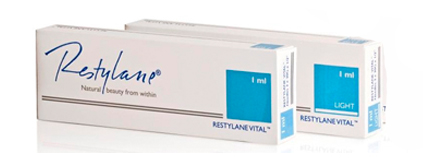Hyaluronic
acid
PRAXI-DENT
NON-PUBLIC HEALTH CARE CENTRE

It is a substance that occurs naturally in the human skin, just as collagen. As we age, a growing loss of this substance is observed, along with increasing flabbiness of the skin – at the age of 40, the loss is 50%, and at the age of 60, up to 90%! Fortunately, administration of hyaluronic acid into the skin not only results in a visible fill effect, but also makes the skin produce new collagen.
It is mainly used for filling the wrinkles in the lower facial area:
– nasolabial furrows
– marionette furrows (below the lip corners)
– lip enlargement/firming
– cheek volume
– smoker’s wrinkle (above the upper lip)
But also for the wrinkles in other surrounding areas, if needed:
– frown line (between the eyes)
– crow’s feet
– scar filling
– tightening of the skin on the face, neck, and décolleté (products with lower density)
At our dental office, we use Retylane products by Q-MED.
What happens during the procedure?
One week before the procedure, you have to stop taking anticoagulant medications (e.g. aspirin) and refrain from drinking large amounts of alcohol, and on the day of the procedure, you should not apply makeup on the target area (any makeup will be removed at the dental office).
After applying skin disinfectants, the product in the form of a colourless gel is injected intradermally with a very thin needle. The injection site is always anaesthetised with Emla cream, and if necessary, infiltration anaesthesia is also used (as with dental anaesthesia) to ensure patient comfort during the procedure. The product itself may also contain an anaesthetic. After the procedure, you should not warm the treated area and avoid sunbathing, sauna and solarium for a week. Do not apply makeup immediately after the the procedure.
Results
Results began to be seen at approx. 3-7 days and last for 4-6 months. After this time, the muscles will gradually regain their original contractile force. The patients do not have worry that their wrinkles will be worse after the effects of the procedure have dissipated. It is just the contrary: wrinkles will be reduced because by that time, the skin will have already regenerated and it will not deform that quickly as a result of the work of the muscles. The procedure should not be repeated more than once every 3 months because of the risk of formation of antibodies against botulinum toxin (which renders the administration ineffective).
Of course, the best results will be seen in younger patients whose wrinkles only begin to appear. At that time, we have a chance to slow down or halt the process of their formation. When wrinkles are already established and visible even at rest, the reduction of wrinkle depth may be less significant, and it may be necessary to wait longer before the results can be seen; furthermore, it may be even necessary to use other methods, e.g. filling with hyaluronic acid.
Effects of botulinum toxin treatment of glabella lines

Possible side effects:
– palpable bulge that softens within 2-3 weeks. In the first week, the administration site can be gently massaged with clean hands, ideally with a fresh cotton pad – a few minutes a day is enough;
– redness, pain, swelling – occur quite often and disappear within 72 hours;
– haematoma, bruising associated with damage to blood vessels in the skin, which disappear within 1-2 weeks; application of ice compresses is recommended;
– in very rare cases, allergic reactions are also possible, as well as local disturbances in blood flow, including development of necrosis
The average effective life of the product in the skin is 1 to 1.5 years. The product is gradually absorbed through the skin. Regular administration of hyaluronic acid into the same areas extends its effective life.

Contraindications
– pregnancy and breastfeeding
– active infection at the administration site, purulent lesions
– inflammatory skin conditions: active cold sore, acne
– autoimmune diseases, collagenoses
– tendency toward hypertrophic scarring
– unstable diabetes
– use of anticoagulants, systemic corticosteroids

